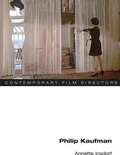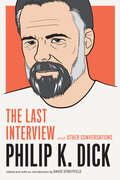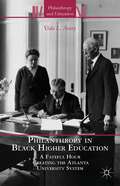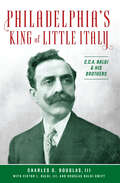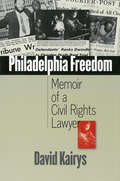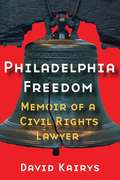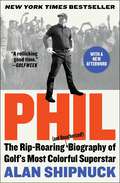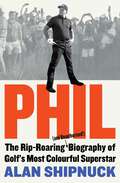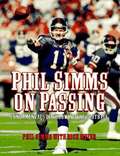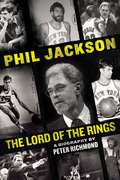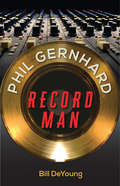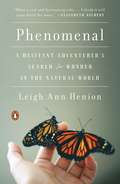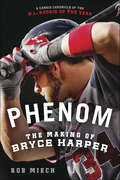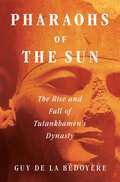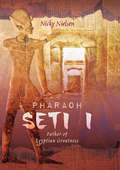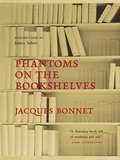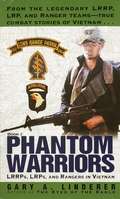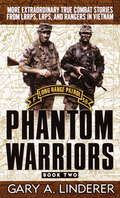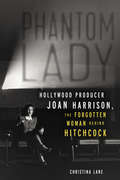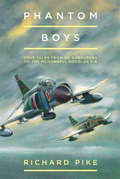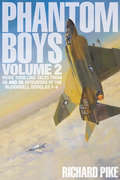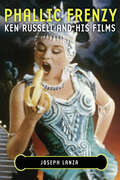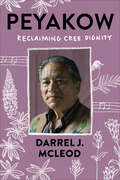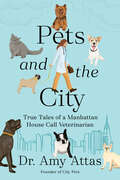- Table View
- List View
Philip Kaufman (Contemporary Film Directors)
by Annette InsdorfAmerican director Philip Kaufman is hard to pin down: a visual stylist who is truly literate, a San Franciscan who often makes European films, he is an accessible storyteller with a sophisticated touch. Celebrated for his vigorous, sexy, and reflective cinema, Kaufman is best known for his masterpiece The Unbearable Lightness of Being and the astronaut saga The Right Stuff. His latest film, Hemingway & Gellhorn(premiering May 2012 on HBO), stars Nicole Kidman and Clive Owen. In this study, Annette Insdorf argues that the stylistic and philosophical richness of Kaufman's cinema makes him a versatile auteur. She demonstrates Kaufman's skill at adaptation, how he finds the precise cinematic device for a story drawn from seemingly unadaptable sources, and how his eye translates the authorial voice from books that serve as inspiration for his films. Closely analyzing his movies to date (including Invasion of the Body Snatchers, The Wanderers, and Quills), Insdorf links them by exploring the recurring and resonant themes of sensuality, artistic creation, codes of honor, and freedom from manipulation. While there is no overarching label or bold signature that can be applied to his oeuvre, she illustrates the consistency of themes, techniques, images, and concerns that permeates all of Kaufman's works.
Philip K. Dick: The Last Interview
by Philip K. Dick David StreitfeldLong before Ridley Scott transformed Do Androids Dream of Electric Sheep? into Blade Runner, Philip K. Dick was banging away at his typewriter in relative obscurity, ostracized by the literary establishment. Today he is widely considered one of the most influential writers of the 20th century. These interviews reveal a man plagued by bouts of manic paranoia and failed suicide attempts; a career fuelled by alcohol, amphetamines, and mystical inspiration; and, above all, a magnificent and generous imagination at work. Series Overview: A new series of pocket-sized interview collections, featuring conversations with some of the iconic writers and thinkers of our time.
Philanthropy In Black Higher Education
by Vida L. AveryThis work describes and analyzes the circumstances surrounding the creation and development of the Atlanta University System (later the Atlanta University Center). The affiliation in 1929 of Atlanta University, Morehouse College, and Spelman College was a monumental event, and John Hope, the first black president of both Morehouse College and Atlanta University and simultaneously president at both of them was key to its taking place. In recounting the circumstances surrounding the affiliation, Vida L. Avery brings to the fore a little-told aspect of the affiliation: the relationships Hope cultivated with industrial philanthropists of his time. These relationships went beyond the simple categories of benefactor and recipient, playing a major role in creating a unique higher educational center for black Americans. "
Philadelphia's King of Little Italy: C.C.A. Baldi & His Brothers (American Heritage)
by Charles G. Douglas Douglas Baldi Swift"C.C.A. Baldi ruled Little Italy, and everyone who wished to deal with the Italians knew it." Go back to turn of the century Philadelphia and discover the incredible immigrant success story of C.C.A. Baldi and his brothers as they build a business empire while pathing a path for the Italian community and becoming the King of Little Italy.
Philadelphia Freedom: Memoir of a Civil Rights Lawyer
by David Kairys"David Kairys is one of the grand long-distance runners in the struggle for justice in America. His brilliant legal mind and superb lawyerly skills are legendary. This marvelous book is his gift to us!" ---Cornel West, Professor of Religion and African American Studies, Princeton University, and award-winning author of Race Matters Philadelphia Freedom is the spellbinding tale of an idealistic young lawyer coming of age in the political cauldron of the 1960s and 1970s. From his immersion in the civil rights movement to his determined court battles to quell criminal violence by Philadelphia police, Kairys recounts how he helped make history in the city of brotherly love." ---William K. Marimow, Editor and Executive Vice President, Philadelphia Inquirer, and recipient of two Pulitzer Prizes "In the current climate of political deception and the trampling of our civil rights, Kairys's compelling book is a clenched fist, a prayer for social justice and a call to conscience." ---Steve Lopez, Los Angeles Times columnist and former Philadelphia Inquirer columnist "With engaging, insider stories of innovative legal strategies of a truly creative lawyer, this book evokes the ebullient spirit of progressive social change launched in the 1960s and should be read by aspiring and practicing lawyers as well as anyone interested in American social history. Philadelphia Freedom reads like a suspense novel and reveals how novel legal and political thinking can and does make a real difference to individuals and to the quality of justice." ---Martha L. Minow, Jeremiah Smith, Jr. Professor of Law, Harvard University "David Kairys's compelling book properly explains the vital role that civil rights attorneys play in our system of justice." ---Judge John E. Jones III, United States District Court for the Middle District of Pennsylvania, and presiding judge in the landmark Kitzmiller v. Dover Area School District case A memoir that is also a compelling page-turner, Philadelphia Freedom is the poignant, informative, often inspiring account of renowned civil-rights lawyer David Kairys's personal quest for achieving social justice during the turbulent 1960s and 70s. Philadelphia Freedom brings us intimately and directly into Kairys's burgeoning law career and the struggles of the 60s as his professional and private life navigated the turmoil and promise of the civil rights and antiwar movements. Many of the cases Kairys took on involved discrimination and equal protection, freedom of speech, and government malfeasance. Kairys is perhaps most well known for his victory in the Camden 28 draft board case, in which the FBI set up a sting of the Catholic anti-war left at the behest of the highest levels of government. The stories and cases range from nationally important and recognizable---the family of the scientist the CIA unwittingly gave LSD in the 1950s; the leading race discrimination case against the FBI; Dr. Benjamin Spock's First Amendment case before the Supreme Court; the city handgun lawsuits Kairys conceived---to those he encountered in his early work as a public defender. The characters include public figures such as FBI Directors J. Edgar Hoover and Louis Freeh; CIA Director William Colby; Pennsylvania Senator Arlen Specter; New York Attorney General Eliot Spitzer; U.S. Attorneys General Edward Levi and John Mitchell; Georgia Governor Lester Maddox; Pennsylvania Governor, former Philadelphia Mayor, and Democratic National Committee chair Ed Rendell; Philadelphia Mayor and Police Commissioner Frank Rizzo. But some of the most memorable are not well known, involving regular people caught up in the often heartless machinery of the courts and legal system. Though it reads like a novel, with all the elements of character, plot, and suspense, Philadelphia Freedom also has historical significance as a firsthand account of the 1960s and 70s and contains social commentary about race as well as insights and major perspectives on the nature and social role of law. David Kairys is Professor of Law at Beasley School of Law, Temple University. He ...
Philadelphia Freedom
by David Kairys"David Kairys is one of the grand long-distance runners in the struggle for justice in America. His brilliant legal mind and superb lawyerly skills are legendary. This marvelous book is his gift to us!" ---Cornel West, Professor of Religion and African American Studies, Princeton University, and award-winning author of Race Matters Philadelphia Freedom is the spellbinding tale of an idealistic young lawyer coming of age in the political cauldron of the 1960s and 1970s. From his immersion in the civil rights movement to his determined court battles to quell criminal violence by Philadelphia police, Kairys recounts how he helped make history in the city of brotherly love." ---William K. Marimow, Editor and Executive Vice President, Philadelphia Inquirer, and recipient of two Pulitzer Prizes "In the current climate of political deception and the trampling of our civil rights, Kairys's compelling book is a clenched fist, a prayer for social justice and a call to conscience." ---Steve Lopez, Los Angeles Times columnist and former Philadelphia Inquirer columnist "With engaging, insider stories of innovative legal strategies of a truly creative lawyer, this book evokes the ebullient spirit of progressive social change launched in the 1960s and should be read by aspiring and practicing lawyers as well as anyone interested in American social history. Philadelphia Freedom reads like a suspense novel and reveals how novel legal and political thinking can and does make a real difference to individuals and to the quality of justice." ---Martha L. Minow, Jeremiah Smith, Jr. Professor of Law, Harvard University "David Kairys's compelling book properly explains the vital role that civil rights attorneys play in our system of justice." ---Judge John E. Jones III, United States District Court for the Middle District of Pennsylvania, and presiding judge in the landmark Kitzmiller v. Dover Area School District case A memoir that is also a compelling page-turner, Philadelphia Freedom is the poignant, informative, often inspiring account of renowned civil-rights lawyer David Kairys's personal quest for achieving social justice during the turbulent 1960s and 70s. Philadelphia Freedom brings us intimately and directly into Kairys's burgeoning law career and the struggles of the 60s as his professional and private life navigated the turmoil and promise of the civil rights and antiwar movements. Many of the cases Kairys took on involved discrimination and equal protection, freedom of speech, and government malfeasance. Kairys is perhaps most well known for his victory in the Camden 28 draft board case, in which the FBI set up a sting of the Catholic anti-war left at the behest of the highest levels of government. The stories and cases range from nationally important and recognizable---the family of the scientist the CIA unwittingly gave LSD in the 1950s; the leading race discrimination case against the FBI; Dr. Benjamin Spock's First Amendment case before the Supreme Court; the city handgun lawsuits Kairys conceived---to those he encountered in his early work as a public defender. The characters include public figures such as FBI Directors J. Edgar Hoover and Louis Freeh; CIA Director William Colby; Pennsylvania Senator Arlen Specter; New York Attorney General Eliot Spitzer; U.S. Attorneys General Edward Levi and John Mitchell; Georgia Governor Lester Maddox; Pennsylvania Governor, former Philadelphia Mayor, and Democratic National Committee chair Ed Rendell; Philadelphia Mayor and Police Commissioner Frank Rizzo. But some of the most memorable are not well known, involving regular people caught up in the often heartless machinery of the courts and legal system. Though it reads like a novel, with all the elements of character, plot, and suspense, Philadelphia Freedom also has historical significance as a firsthand account of the 1960s and 70s and contains social commentary about race as well as insights and major perspectives on the nature and social role of law. David Kairys is Professor of Law at Beasley School of Law, Temple University. He ...
Phil: The Rip-Roaring (and Unauthorized!) Biography of Golf's Most Colorful Superstar
by Alan ShipnuckA juicy and freewheeling biography of legendary golf champion Phil Mickelson—who has led a big, controversial life—as reported by longtime Sports Illustrated writer and bestselling author Alan Shipnuck. <p><p>Phil Mickelson is one of the most compelling figures in sports. For more than three decades he has been among the best golfers in the world, and his unmatched longevity was exemplified at the 2021 PGA Championship, when Mickelson, on the cusp of turning fifty-one, became the oldest player in history to win a major championship. <p><p>In this raw, uncensored, and unauthorized biography, Alan Shipnuck captures a singular life defined by thrilling victories, crushing defeats, and countless controversies. Mickelson is a multifaceted character, and all his warring impulses are on display in these pages: He is a smart-ass who built an empire on being the consummate professional; a loving husband dogged by salacious rumors; a high-stakes gambler who knows the house always wins but can’t tear himself away. <p><p>Mickelson’s career and public image have been defined by the contrast with his lifelong rival, Tiger Woods. Where Woods is robotic and reticent, Mickelson is affable and extroverted, an incorrigible showman whom many fans love and some abhor because of the overwhelming size of his personality. In their early years together on Tour, Mickelson lacked Tiger’s laser focus and discipline, leading Tida Woods to call her son’s rival “the fat boy,” among other put-downs. Yet as Tiger’s career has been curtailed by scandal, addiction, and a broken body, Phil sails on, still relevant on the golf course and in the marketplace. <p><p>Phil is the perfect marriage of subject and author. Shipnuck has long been known as the most fearless writer on the golf beat, and he delivers numerous revelations, from the true scale of Mickelson’s massive gambling losses; to the inside story of the acrimonious breakup between Phil and his longtime caddie, Jim “Bones” Mackay; to the secretive backstory of the Saudi golf league that Mickelson championed to wield as leverage against the PGA Tour. <p><p>But Phil also celebrates Mickelson’s random acts of kindness and generosity of spirit, to which friends and strangers alike can attest. Shipnuck has covered Mickelson for his entire career and has been on the ground at Mickelson’s most memorable triumphs and crack-ups, allowing him to take readers inside the ropes with a thrilling immediacy and intimacy. The result is the juiciest and liveliest golf book in years—full of heart, humor, and unexpected turns. <p> <b>New York Times Bestseller</b>
Phil: The Rip-Roaring (and Unauthorized!) Biography of Golf's Most Colorful Superstar
by Alan ShipnuckA frank and revealing biography of legendary golf champion Phil Mickelson - who has led a big, controversial life - as reported by longtime Sports Illustrated writer and bestselling author Alan Shipnuck.Phil Mickelson is one of the most compelling figures in sports. For more than three decades he has been among the best golfers in the world, and his unmatched longevity was exemplified at the 2021 PGA Championship, when Mickelson, on the cusp of turning fifty-one, became the oldest player in history to win a major championship. In this raw and unauthorised biography, Shipnuck captures a singular life defined by thrilling victories, crushing defeats and countless controversies. Mickelson is a multi-faceted character, and all his warring impulses are on display in these pages: he is a smart-ass who built an empire on being the consummate professional; a loving husband dogged by salacious rumours; a high-stakes gambler who knows the house always wins but can&’t tear himself away.Mickelson&’s career and public image have been defined by the contrast with his lifelong rival, Tiger Woods. Where Woods is robotic and reticent, Mickelson is affable and extroverted, an incorrigible showman. In their early years together on Tour, Mickelson lacked Tiger&’s laser focus and discipline, yet as Tiger&’s career has been curtailed by scandal, addiction and a broken body, Phil sails on, still relevant on the golf course and in the marketplace.Phil is the perfect marriage of subject and author. Shipnuck delivers numerous revelations, from the true scale of Mickelson&’s massive gambling losses to the secretive backstory of the Saudi golf league that Mickelson championed. But Phil also celebrates Mickelson&’s random acts of kindness and generosity of spirit, to which friends and strangers alike can attest. Shipnuck has covered Mickelson for his entire career, allowing him to take readers inside the ropes with a thrilling immediacy and intimacy. The result is the juiciest and liveliest golf book in years - full of heart, humour and unexpected turns.
Phil Simms on Passing: Fundamentals of Throwing the Football, First Edition
by Phil Simms Rick MeierIn this book, Simms, a former star quarterback in the National Football League, elucidates the fundamental steps and movements involved in throwing the football that will help quarterbacks of all ages and experience pass with greater accuracy, speed, and consistency.
Phil Jackson
by Peter RichmondWith eleven championship rings to his name, Phil Jackson is internationally recognized as one of the greatest coaches in the history of the NBA. Known as a defensive disrupter and a master fouler during his early days as a New York Knick and later celebrated as the "Zen Master" for his inspirational tactics as a leader, Jackson has had a long and storied career marked by constant self-reflection and reinvention. This is the man who led Michael Jordan and the Chicago Bulls to six championships, Kobe Bryant and the Los Angeles Lakers to five; who was inducted into the Basketball Hall of Fame; and who retired in 2011, an official legend--and the most sought-after free-agent coach in history. As befits a legend, Jackson has written several candid, insightful books about his life and career, but now one of America's most respected sportswriters turns an unvarnished light on Jackson's strange and remarkable journey, from his sheltered childhood and adolescence in Montana and North Dakota, through his years playing at Madison Square Garden, to his experiences coaching Jordan, Bryant, and more of the greatest players of our time. New York Times-bestselling author Peter Richmond has written a personal, definitive, revealing biography of a veritable sports genius, and an American classic.
Phil Gernhard, Record Man
by Bill DeYoungA go-getting, red-headed college kid eager to break into the music business, Phil Gernhard produced a handful of singles for South Carolina doo-wop group Maurice Williams and the Zodiacs. One of these songs, "Stay," reached number one on the charts in 1960. Gernhard was just 19 years old. Phil Gernhard, Record Man is the story of a self-made music mogul who created nearly fifty years' worth of chart-topping songs. From a tiny office and studio in Florida, he co-wrote the Royal Guardsmen's "Snoopy vs. the Red Baron," America's fastest-selling single of 1966. He revived the career of singer Dion DiMucci with the ballad "Abraham, Martin and John"--a million seller. He discovered and produced hit records for Lobo, Jim Stafford, and the Bellamy Brothers. Through a long collaboration with music business icon Mike Curb, he launched to fame many others, including country superstars Tim McGraw and Rodney Atkins. In Nashville and Los Angeles, Phil Gernhard was a legend. Yet Gernhard's private life was crumbling. He battled physical and emotional demons that he simply couldn't overcome, struggling with alcoholism, drug addiction, and a bad past with his father. He filed for his fourth divorce just months before taking his own life in 2008. Through interviews with Gernhard's musicians, business partners, family members, and ex-wives, Bill DeYoung offers an intimate portrait of a brilliant yet troubled man who channeled his talent, ego, and ambition into the success of others. A true "record man," Gernhard did it all. He lived to make records into gold, to make unknowns into stars, and above all, to make music.
Phenomenal
by Leigh Ann HenionElizabeth Gilbert, author of The Signature of All Things and Eat, Pray, Love "What a cool and fascinating ride. Leigh Ann Henion has tackled one of the great questions of contemporary, intelligent, adventurous women: Is it possible to be a wife and mother and still explore the world? Her answer seems to be that this is not only possible, but essential. This story shows how. I think it will open doors for many." Heartfelt and awe-inspiring, Leigh Ann Henion's Phenomenal is a moving tale of physical grandeur and emotional transformation, a journey around the world that ultimately explores the depths of the human heart. A journalist and young mother, Henion combines her own varied experiences as a parent with a panoramic tour of the world's most extraordinary natural wonders. Phenomenal begins in hardship: with Henion deeply shaken by the birth of her beloved son, shocked at the adversity a young mother faces with a newborn. The lack of sleep, the shrinking social circle, the health difficulties all collide and force Henion to ask hard questions about our accepted wisdom on parenting and the lives of women. Convinced that the greatest key to happiness--both her own and that of her family--lies in periodically venturing into the wider world beyond home, Henion sets out on a global trek to rekindle her sense of wonder. Henion's quest takes her far afield, but it swiftly teaches her that freedom is its own form of parenting--one that ultimately allows her to meet her son on his own terms with a visceral understanding of the awe he experiences every day at the fresh new world. Whether standing on the still-burning volcanoes of Hawai'i or in the fearsome lightning storms of Venezuela, amid the vast animal movements of Tanzania or the elegant butterfly migrations of Mexico, Henion relates a world of sublimity and revelation. Henion's spiritual wanderlust puts her in the path of modern-day shamans, reindeer herders, and astrophysicists. She meets laypeople from all over the world, from all walks of life, going to great lengths to chase migrations, auroras, eclipses, and other phenomena. These seekers trust their instincts, follow their passions, shape their days into the lives they most want to lead. And, somewhere along the way, Leigh Ann Henion becomes one of them. A breathtaking memoir, Phenomenal reveals unforgettable truths about motherhood, spirituality, and the beauty of nature.Oprah.com"Part travel memoir, part parenting manifesto and part inquiry into those 'fleeting, extraordinary glimpses of something that left us groping for rational explanations in the quicksand of all-encompassing wonder.'"From the Hardcover edition.
Phenom: The Making of Bryce Harper
by Rob MiechPhenom: The Making of Bryce Harper presents a look back at the controversial college season that launched the 2010 MLB #1 draft pick's professional career and earned the then 17-year-old phenom the Golden Spikes Award for the nation's top player.Before Bryce Harper was the top pick in the Major League Baseball draft, before he signed the sport's biggest contract ever for a first-year pro, he gambled his future on one make-or-break season.The Las Vegas High School sophomore already had dominated the competition like Mickey Mantle on the playground and appeared on the cover of Sports Illustrated, which dubbed him the "most exciting prodigy since LeBron James." Seeking greater tests as a hitter, the precocious phenom got his GED and enrolled at the College of Southern Nevada, where he could face pro prospects in a challenging wooden-bat league that prohibited the hitter-friendly aluminum bats used throughout college ball. Harper shattered the school's home run record with 31 (the previous mark was 12) and compiled a startling 1.513 OPS while leading his team to the Junior College World Series. For his heroics, the 17-year-old became the only position player from a junior college to win the Golden Spikes Award, given to the nation's best amateur baseball player. Las Vegas sportswriter Rob Miech was "embedded" with the Southern Nevada Coyotes team and brings us along for the ride—into the dugout and locker room and on team buses and in motel rooms, from the scorched fields to the snow-capped horizons of the Scenic West Athletic Conference—to deliver a warts-and-all account of a boy among men playing like a man among boys. Amid the media circus that descended upon team and town, we read fascinating personal stories including the dynamics between veteran coach Tim Chambers and Harper's protective father, the camaraderie with—and jealousies of—other players, the fans and autograph seekers (and girls) who all want a piece of the young star, and how Harper is suspended from the World Series after protesting an umpire's call, and the role his faith plays in his life. Phenom shows us a season in the life of baseball's top rising star, culminating in a dramatic conclusion when Harper is drafted #1 by the Washington Nationals and, after tense negotiations that go up until just seconds before the midnight deadline, signs a $9.9 million contract. Even more than this, Miech's book is the story of a team and its community, the hopes and aspirations of its players and coaches, and the spirit of pure baseball that lies at the heart of the American dream.
Pharaohs of the Sun: The Rise and Fall of Tutankhamun's Dynasty
by Guy de la BédoyèreA vivid story of an astonishing period in ancient Egypt&’s history—1550 BC to 1295 BC—that tears away the gold and glamour to reveal how these great pharaohs ruthlessly ruled Egypt for two hundred and fifty years. For more than two centuries, Egypt was ruled by the most powerful, successful, and richest dynasty of kings in its long end epic history. They included the female king Hatshepsut, the warrior kings Thutmose III and Amenhotep II, the religious radical Akhenaten and his queen, Nefertiti, and most famously of all—for the wealth found in his tomb—the short-lived boy king, Tutankhamun. The power and riches of the Pharaohs of the 18th Dynasty came at enormous cost to Egypt's enemies—and to most of its people. This was an age of ruthless absolutism, exploitation, extravagance, brutality, and oppression in a culture where not only did Egypt plunder its neighbors, but Egyptian kings (and their people) robbed one another. 3,500 years ago, ancient Egypt began two centuries of growth where it became richer and more powerful than any other nation in the world, ruled by the kings of the 18th Dynasty. They presided over a system built on war, oppression, and ruthlessness, pouring Egypt's wealth into grandiose monuments, temples, and extravagant tombs. Tutankhamun was one of the last of the line—and one of the most obscure. Among his predecessors were some of the most notorious and enigmatic figures of all of Egypt's history. Pharaohs of the Sun is the story of these famed rulers, showing how their glamour and gold became tainted by selfishness, ostentation, and the systematic exploitation of Egypt's people and enemies.
Pharaoh Seti I: Father of Egyptian Greatness
by Nicky NielsenPharaoh Seti I ruled Egypt for only 11 years (1290-1279 BC), but his reign marked a revival of Egyptian military and economic power, as well as cultural and religious life. Seti was born the son of a military officer in northern Egypt, far from the halls of power in Memphis and Thebes. However, when the last king of the 18th Dynasty, Horemheb, died without an heir, Setis father was named king. He ruled for only two years before dying of old age, leaving Seti in charge of an ailing superpower. Seti set about rebuilding Egypt after a century of dynastic struggles and religious unrest. He reasserted Egypts might with a series of campaigns across the Levant, Libya and Nubia. He despatched expeditions to mine for copper, gold, and quarry for stone in the deserts, laying the foundations for one of the most ambitious building projects of any Egyptian Pharaoh and his actions allowed his son, Ramesses the Great to rule in relative peace and stability for 69 years, building on the legacy of his father.
Phantoms on the Bookshelves
by Jacques BonnetThis enchanting study on the art of living with books considers how our personal libraries reveal our true nature: far more than just places, they are living labyrinths of our innermost feelings. The author, a lifelong accumulator of books both ancient and modern, lives in a house large enough to accommodate his many thousands of books, as well as overspill from the libraries of his friends. While his musings on the habits of collectors past and present are learned, witty and instructive, his advice on cataloguing may even save the lives of those whose books are so prodigiously piled as to be a hazard... The Phantoms on the Bookshelves ranges from classical Greece to contemporary Iceland, from Balzac and Moby Dick to Google, offering up delicious anecdotes along the way. This elegantly produced volume will be a lasting delight to specialist collectors, librarians, bibliophiles and all those who treasure books.
Phantoms on the Bookshelves
by Jacques BonnetThis enchanting study on the art of living with books considers how our personal libraries reveal our true nature: far more than just places, they are living labyrinths of our innermost feelings. The author, a lifelong accumulator of books both ancient and modern, lives in a house large enough to accommodate his many thousands of books, as well as overspill from the libraries of his friends. While his musings on the habits of collectors past and present are learned, witty and instructive, his advice on cataloguing may even save the lives of those whose books are so prodigiously piled as to be a hazard... The Phantoms on the Bookshelves ranges from classical Greece to contemporary Iceland, from Balzac and Moby Dick to Google, offering up delicious anecdotes along the way. This elegantly produced volume will be a lasting delight to specialist collectors, librarians, bibliophiles and all those who treasure books.
Phantom Warriors: Book I: LRRPs, LRPs, and Rangers in Vietnam (Phantom Warriors #1)
by Gary LindererHere are some of the most courageous missions executed by six-man teams on their own deep behind enemy lines.
Phantom Warriors: Book 2
by Gary LindererMORE GRIPPING, NO-HOLDS-BARRED LRRP ACCOUNTSFROM THE FRONT LINESDuring the Vietnam War, few combat operations were more dangerous than LRRP/Ranger missions. Vastly outnumbered, the patrols faced overwhelming odds as they fought to carry out their missions, from gathering intelligence, acting as hunter/killer teams, or engaging in infamous "Parakeet" flights- actions in which teams were dropped into enemy areas and expected to "develop" the situation. PHANTOM WARRIORS II presents heart-pounding, edge-of-your-seat stories from individuals and teams. These elite warriors relive sudden deadly firefights, prolonged gun battles with large enemy forces, desperate attempts to help fallen comrades, and the sheer hell of bloody, no-quarter combat. The LRRP accounts here are a testament to the courage, guts, daring, and sacrifice of the men who willingly faced death every day of their lives in Vietnam.From the Paperback edition.
Phantom Lady: Hollywood Producer Joan Harrison, the Forgotten Woman Behind Hitchcock
by Christina LaneIn 1933, Joan Harrison was a twenty-six-year-old former salesgirl with a dream of escaping both her stodgy London suburb and the dreadful prospect of settling down with one of the local boys. A few short years later, she was Alfred Hitchcock's confidante and one of the Oscar-nominated screenwriters of his first American film, Rebecca. Harrison had quickly grown from being the worst secretary Hitchcock ever had to one of his closest collaborators, critically shaping his brand as the "Master of Suspense." Forging her own public persona as the female Hitchcock, Harrison went on to produce numerous Hollywood features before becoming a television pioneer as the producer of Alfred Hitchcock Presents. A respected powerhouse, she acquired a singular reputation for running amazingly smooth productions— and defying anyone who posed an obstacle. She built most of her films and series from the ground up. She waged rough-and-tumble battles against executives and censors, and even helped to break the Hollywood blacklist. She teamed up with many of the most respected, well-known directors, writers, and actors of the twentieth century. And she did it all on her own terms. Author Christina Lane shows how this stylish, stunning woman became Hollywood's most powerful female writer-producer—one whom history has since overlooked.
Phantom Boys: True Tales from UK Operators of the McDonnell Douglas F-4
by Richard Pike&“A cracking read&” on the twin-engined supersonic long-range fighter bomber from the bestselling author of the Hunter Boys and Lightning Boys volumes (Britain at War). Originally developed for the US Navy, the McDonnell Douglas F-4 fighter-bomber first flew in the spring of 1958. It then entered service for the US Navy in 1961, and in 1969 with the Fleet Air Arm and RAF in the UK. Regarded as one of the most versatile fighters ever built, the Phantom F-4 was the US Navy&’s fastest and highest-flying aircraft. It was flown by both US military demonstration teams (Navy Blue Angels and the Air Force Thundercats) from 1969 to 1973. It ended its service in 1991 with the RAF. But it continues to serve a variety of air forces across the world, with some still in service fifty years after its first flight. Throughout the twenty chapters of this book, thirteen contributors will take readers across the world with adventures in the Falkland Islands, the United States of America, the United Kingdom, the Far East and Germany. There are anecdotes of reconnaissance missions, encounters with the Russian Tupolevs, record-breaking flights and life on HMS Ark Royal. The scope, flair and pace of the writing in this book will appeal to the general reader as well as to the enthusiast.
Phantom Boys Volume 2: More Thrilling Tales From UK and US Operators of the McDonnell Douglas F-4
by Richard PikeThe highly anticipated follow-up has &“more scintillating stories from both the front and rear cockpits of one of the world&’s most legendary jet fighters&” (Air Classics). Once again Richard Pike has brought together brilliant, hitherto unpublished accounts across eighteen chapters. And now there is coverage of the Americans. So, with both British and American perspectives, Phantom Boys 2 is packed with exhilarating action. From combat in the Vietnam War to life after the Falklands War, readers will experience a variety of wartime and peacetime tales. An array of narratives from air and ground crew cover adventures across the world; from the UK, US and Germany to the Far East. It also includes the fascinating story of one female fighter controller&’s chance to fly in a Phantom during the 1970s. Throughout the book Richard Pike captures the drama and emotion of life in the cockpit. With such detailed stories, readers will be gripped by this captivating book.&“Pike has done an excellent job of drawing the reader into the cockpit and then into the skies. The shared tales are engaging and quickly read. While each tale is relatively short—typically less than fifteen pages—all are packed with the detalis, sights, and sounds of flying one of the modern age&’s most iconic jet fighters.&” —Air Power History
Phallic Frenzy: Ken Russell and His Films
by Joseph LanzaA biography of director Ken Russell that details the wild ideas, surreal moments, personal faith, and cavalcade of colorful personalities surrounding this eccentric filmmaker--on and off the set. Best known for the acclaimed movies Altered States, The Devils, Gothic, The Music Lovers, Tommy, and Women in Love, Russell redefined cinema in the 1960s, 70s and 80s, working with magnetic actors like Jack Nicholson, Michael Caine, Ann-Margret, William Hurt, Gabriel Byrne, and Vanessa Redgrave. Moments of Russell's career are highlighted in this intimate biography, including how creative differences between Russell and producer Robert Stigwood stopped production of a movie version of Evita, how he creatively staged the love duet between Faust and Helen over a bowl of pasta in the opera Mephistopheles, and how Alan Bates and Oliver Reed compared their penis size for the nude wrestling scene in Women in Love.
Peyakow: Reclaiming Cree Dignity
by Darrel J. McLeodFollowing his award-winning debut memoir, Mamaskatch, which masterfully portrayed a Cree coming-of-age in rural Canada, Darrel J. McLeod continues the poignant story of his adulthood. In Mamaskatch, McLeod captured an early childhood full of the stories, scents, and sensations of his great-grandfather’s cabin, as well as the devastating separation from family, ensuing abuse, and eventual loss of his mother that permeated his adolescence. In the equally potent Peyakow, McLeod follows a young man through many seasons of his life, navigating an ever-turbulent personal and political landscape filled with loss, love, addiction, and perseverance. Guided internally by his deep connection to his late grandfather, in a constant quest for happiness, McLeod strives to improve his own life as well as the lives of Indigenous peoples in Canada and beyond. This leads him to a multifaceted career and life as a school principal, chief treaty negotiator, executive director of education and international affairs, representative of an Indigenous delegation to the United Nations in Geneva, jazz musician, and, today, celebrated author. Weaving together the past and the present through powerful, linked chapters, McLeod confronts how both the personal traumas of his youth and the historical traumas of his ancestral line impact the trajectory of his life. With unwavering and heart-wrenching honesty, Peyakow—Cree for “one who walks alone”—recounts how one man carries the spirit of his family through the lifelong process of healing.
Pets and the City: True Tales of a Manhattan House Call Veterinarian
by Dr. Amy AttasOne of Washington Post&’s 5 &“Feel-Good Books&” of Summer 2024New York City&’s premier &“house call veterinarian&” takes you into the exclusive penthouses and four-star hotel rooms of the wealthiest New Yorkers and shows that, when it comes to their pets, they are just as neurotic as any of us.When a pet is sick, people—even the rich and famous—are at their most authentic and vulnerable. They could have a Monet on the wall and an Oscar on the shelf, but if their cat gets a cold, all they want to talk about are snotty noses and sneezing fits. That&’s when they call premier in-home veterinarian Dr. Amy Attas.In Pets and the City, Dr. Amy shares all the funny, heartbreaking, and life-affirming experiences she&’s faced throughout her thirty-year career treating the cats and dogs of New Yorkers from Park Avenue to the projects. Some of her stories are about celebs, like the time she saw a famous singer naked (no, her rash was not the same as her puppy&’s). Others are about remarkable animals, like the skilled service dog who, after his exam was finished, left the room and returned with a checkbook in his mouth. Every tale in this rollicking, informative, and fun memoir affirms a key truth about animal, and human, nature: Our pets love us because their hearts are pure; we love them because they&’re freaking adorable. On some level, we know that by caring for them, we are the best version of ourselves. In short: Our pets make us better people.
